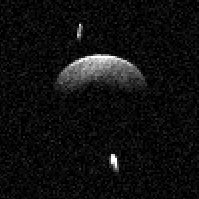(153591) 2001 SN263
Near-Earth asteroid From Wikipedia, the free encyclopedia
(153591) 2001 SN263 is a carbonaceous triple[3] asteroid, classified as near-Earth object and former potentially hazardous asteroid of the Amor group, approximately 2.6 kilometers (1.6 miles) in diameter. It was discovered by the Lincoln Near-Earth Asteroid Research project at Lincoln Lab's Experimental Test Site in Socorro, New Mexico, on 20 September 2001.[1] The two synchronous minor-planet moons measure approximately 770 and 430 meters and have an orbital period of 16.46 and 150 hours, respectively.[4][10]
 Radar image of 2001 SN263 and its two satellites imaged by the Arecibo Observatory in 2008 | |
| Discovery[1] | |
|---|---|
| Discovered by | LINEAR |
| Discovery site | Lincoln Lab's ETS |
| Discovery date | 20 September 2001 |
| Designations | |
| (153591) 2001 SN263 | |
| 2001 SN263 | |
| NEO · Amor[1][2] | |
| Orbital characteristics[2] | |
| Epoch 4 September 2017 (JD 2458000.5) | |
| Uncertainty parameter 0 | |
| Observation arc | 25.18 yr (9,198 days) |
| Aphelion | 2.9368 AU |
| Perihelion | 1.0363 AU |
| 1.9865 AU | |
| Eccentricity | 0.4783 |
| 2.80 yr (1,023 days) | |
| 148.57° | |
| 0° 21m 7.2s / day | |
| Inclination | 6.6853° |
| 325.83° | |
| 172.86° | |
| Known satellites | 2[3] |
| Earth MOID | 0.0520 AU · 20.3 LD |
| Physical characteristics | |
| 2 km[3] 2.5±0.3 km[4] 2.6 km[5] 2.63±0.40 km[6] | |
| Mass | (917.5±2.2)×1010 kg[7] |
Mean density | 1.1±0.2 g/cm3[4] |
| 3.20±0.01 h[8] 3.423±0.001 h[a] 3.42510±0.00007 h[9] 3.4256±0.0002 h[4] | |
| 0.048±0.015[6] | |
| C[8] · B[b] | |
| 16.81[10] · 16.9[2] | |
Numbering and naming
This minor planet was numbered by the Minor Planet Center on 2 April 2007.[11] As of 2018, the primary and its moons have not been named.[1] In the scientific literature, the components of the triple system are generically referred to as Alpha, Beta and Gamma, but these labels are not recognized by the IAU.[5][4]
Primary
Summarize
Perspective
2001 SN263, the primary object of this triple system, is an unusual carbonaceous near-Earth asteroid of a C- or somewhat brighter B-type.[8][b] It orbits the Sun at a distance of 1.0–2.9 AU once every 2 years and 10 months (1,023 days). Its orbit has an eccentricity of 0.48 and an inclination of 7° with respect to the ecliptic.[2] A first precovery was taken at Palomar Observatory during the Digitized Sky Survey in 1990, extending the body's observation arc by 11 years prior to its official discovery observation at Socorro.[1]
It has an Earth minimum orbital intersection distance (MOID) of 0.0520 AU (7,780,000 km), which translates into 20.3 lunar distances.[2] With an Earth MOID above 0.05 AU, 2001 SN263 is no longer a potentially hazardous asteroid, but it was classified as such by the MPC until early 2017.[1][12]
Radar observations show that it measures 2.5 kilometers in diameter.[4] Its surface has a low albedo of 0.048.[6] Rotational lightcurves obtained from photometric observations gave a rotation period of 3.423 hours (best result) with a brightness variation between 0.13 and 0.27 magnitude (U=2/3/3).[8][9][a] Radar observations gave a concurring period of 3.4256 hours, and subsequent modeling of both radiometric and photometric observations gave a spin axis of (309.0°, −80.0°) in ecliptic coordinates (λ, β).[4]
Triple system
Summarize
Perspective
In 2008, scientists using the planetary radar at Arecibo Observatory discovered that the object is orbited by two satellites, when the triple asteroid made a close approach to Earth of 0.066 AU (nearly 10 million kilometers). The largest body (preliminarily called Alpha) is spheroid in shape, with principal axes of 2.8±0.1 km, 2.7±0.1 km, and 2.9±0.3 km, with an effective diameter of 2.5±0.3 km and a density of 1.1±0.2 g/cm3. The satellites, named Beta and Gamma, are several times smaller in size. Beta is 0.77±0.12 km in diameter and Gamma 0.43±0.14 km.[4]
The only other unambiguously identified triple asteroids in the near-Earth population are (136617) 1994 CC, which was discovered to be a triple system in 2009, and 3122 Florence, which was found to be a triple system in September 2017.[13]
Orbital characteristics of satellites
The orbital properties of the satellites are listed in this table.[7] The orbital planes of both satellites are inclined relative to each other; the relative inclination is about 14 degrees. Such a large inclination is suggestive of past evolutionary events (e.g. close encounter with a terrestrial planet, mean-motion-resonance crossing) that may have excited their orbits from a coplanar configuration to an inclined state.
| Name | Mass (est.) | Semi-major axis | Orbital period | Eccentricity |
|---|---|---|---|---|
| Gamma (inner) | 10×1010 kg | 3.8 km | 0.686 days | 0.016 |
| Beta (outer) | 24×1010 kg | 16.6 km | 6.225 days | 0.015 |
Exploration
This triple asteroid system is the target for the planned ASTER mission scheduled for launch in 2025 by the Brazilian Space Agency.[14]
Notes
- Warner (2011) web: lightcurve plot of (153591) 2001 SN263, Palmer Divide Observatory, Brian D. Warner (2008). Photometric observations from 20 February 2008: rotation period 3.423±0.001 hours with a brightness amplitude of 0.14±0.02 magnitude. Quality code: 3. Summary figures for all obtained lightcurves at Collaborative Asteroid Lightcurve Link (CALL) for (153591)
- Perna (2014): photometric observation from 24 June 2011: with a brightness amplitude of mag. Summary figures at Collaborative Asteroid Lightcurve Link (CALL) for (153591)
References
External links
Wikiwand - on
Seamless Wikipedia browsing. On steroids.
